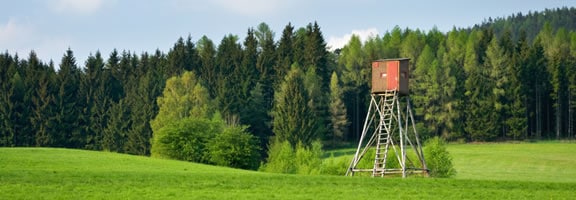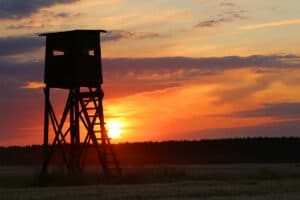The answer to the question in this title is pretty straightforward – not only are large acreage recreational property values lower than they have been in almost ten years, an abundance of quality tracts are also currently on the market. The first thought that this response most likely evokes from a prospective buyer is, given the current uncertainty with the economy, the smart play is to wait, let prices continue to drop, then pull the trigger on that dream property. This scenario sounds simple enough – why would anyone want to buy right now?
Although the odds of finding that perfect property at a very reasonable price are high right now, this window of opportunity will not last forever. Land prices will eventually bottom out and start the recovery process. Even more important than the recovery of land prices to a potential buyer is the inevitable reduction of quality tracts on the market. Once land prices stabilize, the first tracts to go are sure to be the best ones. By waiting for land prices to continue falling, a buyer is risking an opportunity to purchase a quality tract at a great price that probably has not been on the market for a long time and most likely will not be on the market again anytime soon.
The purchase of a large acreage recreational tract is typically a substantial long-term investment which requires much deliberation. The main objective for a majority of buyers is getting a great deal on a tract that meets all of their requirements. Many buyers are currently hesitant to move forward in the purchasing process and this hesitancy is justified by the uncertainty of land prices recovering. For those considering the purchase of a recreational property take a look at the following statistics from the United States Department of Agriculture during the Great Depression:
“Agricultural land values saw the largest percentage declines of the century in the early 1930’s, the beginning of the Great Depression. Agricultural land values dropped 37 percent over a period of 3 years and remained between $30 and $33 per acre throughout the 1930’s. Following the Great Depression, land values were revitalized and began a climb that continued until the early 1980’s.”
Over the last three years the majority of large tracts of recreational property in upstate South Carolina have been losing value. Overall, these properties are currently pushing a 30 percent loss in value since land prices started declining. An increasing number of recreational properties currently on the market have experienced major price reductions that reflect this 30 percent loss in value. A legitimate argument is the current recession has lasted longer than anyone anticipated and we are close to a recovery but it will be a slow one. If this argument proves true a valid assessment of current land values is that although they have bottomed out, the time frame for recovering value will be significant. As the slow recovery reveals itself the transactions on quality recreational tracts will increase in frequency as buyers gain more certainty that land values are increasing. Therefore, the best time to get serious about purchasing a large acreage recreational tract is now. The substantial inventory of nice recreational properties with values 30 percent below pre-recession values will not last long and continuing to wait could very well result in missing out on the chance to purchase that ideal tract at a great price.
This content may not be used or reproduced in any manner whatsoever, in part or in whole, without written permission of LANDTHINK. Use of this content without permission is a violation of federal copyright law. The articles, posts, comments, opinions and information provided by LANDTHINK are for informational and research purposes only and DOES NOT substitute or coincide with the advice of an attorney, accountant, real estate broker or any other licensed real estate professional. LANDTHINK strongly advises visitors and readers to seek their own professional guidance and advice related to buying, investing in or selling real estate.










Rusty, thanks for a great article. There is no shortage of available recreational properties in Alabama, and many owners have become resigned to the fact that sell prices are lower these days.
This is a great time for a buyer to pick up recreational and timberland properties because the farmland segment is seeing so much activity. The old addage, “All of the money is made when you buy.” is true for these types of purchases as well.
Thanks again for an insightful article.
Thanks Johnathan. It seems a majority of buyers are still hesitant to move forward due to uncertainty concerning recreational land values. That being said buyer activity seems to be gaining momentum and by the time the recovery is in full swing it is very likely savvy investors will have transacted on the high end properties.
I agree with Jonathan, great article! Although farm land is hot, this makes the recreational land market a quiet opportunity for investors to buy low and sell high (when the market comes back). This is also true in the great lakes states where inventory continues to grow and the supply of able and willing buyers continues to dwindle. It won’t be long before people catch on and the price of land begins to rise.
Well said Rusty! I also agree with Jonathan and Jonathan. I have seen a tremendous increase in people looking to put money into land rather than the stock market over the past two years. I think two of the largest reasons are people not trusting the staock market/ the lack of returns or losses in the recent past and that people are now putting land into retirement portfolios where they can have something tangible.
I concurr with the strategy presented. My personal preferrence is INCOME plus APPRECIATION with USDA programs adding to
the mix with their enhancements.
Question? What are some good links to find LARGE (500+ ac) TRACTS??
Hi Tomy. You can find large tracts at these sites in the LANDFLIP network.
http://www.landflip.com
http://www.farmflip.com
http://www.ranchflip.com
Tomy,
Give me a call or email me. I know of several great recreational properties price rightin Colorado. 719-783-9052
The forces described in this article do not just apply to large tracts, but land of any size. The best properties will be the first to go. Does this surprise anyone? There is nothing in this article specific only to large tracts.
Alex,
Thanks for the critique. The argument in my article that is specific to large, high-end recreational tracts is the idea that there is a limited number of these types of properties as well as an overall unwillingness to sell normally associated with these types of properties (whether family ties, historical significance, years spent working the land,etc.)
The recent recession has forced many of these otherwise unwilling owners to put their properties up for sale for a fraction of what they were once worth.
The result is a very unique opportunity to purchase a large, high-end recreational tract that most likely hasn’t been on the market in a decade.
I could have done a better job clarifying this point and I appreciate your input.